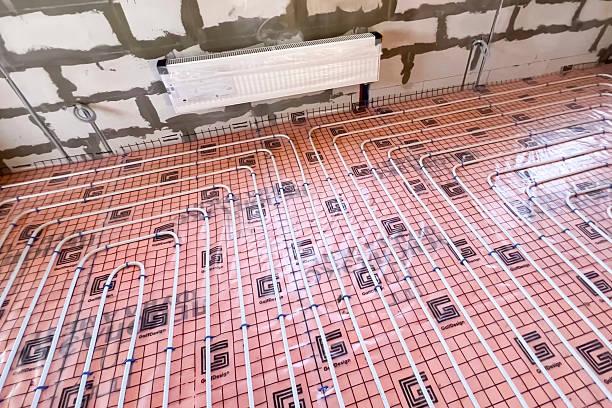Expert Installation Tips for Radiant Floor Heating Systems

HVAC Blog Spot provides homeowners and contractors with essential insights for installing Radiant Floor Heating Systems efficiently and effectively. These systems have become increasingly popular due to their energy efficiency, comfort, and ability to evenly heat living spaces. Whether using hydronic floor heating or electric radiant heating, proper installation is critical for long-term performance, safety, and energy savings.
Investing in a well-designed and professionally installed radiant heating system ensures a cozy, warm environment, reduces energy bills, and increases the overall value of your home. In this guide, we’ll share expert tips, best practices, and considerations for anyone planning to install a warm floor system.
Understanding Radiant Floor Heating Systems
Radiant heating works by warming floors through either water-based (hydronic) or electric systems. The heat then radiates upward, creating a consistent, comfortable temperature. This method contrasts with traditional forced-air systems, which can create uneven heating and airflow issues.
Radiant Floor Heating Systems are compatible with a variety of flooring types, including tile, stone, engineered wood, and even carpet, making them a versatile home heating solution. Understanding the type of system you choose is the first step in a successful installation.
Planning Your Installation
Proper planning is key to a smooth installation. Begin by measuring the area to determine the heating requirements. Consider factors such as:
-
Room size and layout
-
Floor material and insulation
-
Desired comfort level
-
Energy efficiency goals
Well-thought-out planning ensures that your radiant heating system performs optimally and avoids uneven heating or excessive energy consumption.
Choosing the Right System
There are two main types of radiant floor heating:
-
Hydronic floor heating: Uses heated water circulating through pipes beneath the floor. Ideal for larger areas and whole-home systems.
-
Electric radiant heating: Uses electric mats or cables. Perfect for smaller rooms or retrofit applications.
Selecting the right system depends on your home’s layout, budget, and energy efficiency goals. Both types provide consistent warmth, but installation techniques differ.
Preparing the Subfloor
A proper subfloor is crucial for efficiency and longevity. Key steps include:
-
Ensuring a clean, level surface
-
Adding insulation to prevent heat loss
-
Checking for moisture or damage
A well-prepared subfloor allows radiant floor heating systems to distribute heat evenly and improves overall energy efficiency.
Laying the Heating Elements
For electric radiant heating, carefully roll out mats or lay cables according to manufacturer's instructions. Maintain proper spacing to avoid cold spots.
For hydronic systems, install piping loops evenly and secure them to the subfloor or insulation board. Use appropriate fittings, manifolds, and pressure testing to ensure the system functions safely and efficiently.
Connecting to the Heating Source
Hydronic systems require a boiler or water heater to circulate warm water through the underfloor piping, while electric systems connect to the home’s electrical panel. It is essential to ensure all connections are properly secured, thermostats are correctly installed, and safety devices such as breakers or sensors are in place according to local building codes. Proper installation at this stage is critical not only for efficiency but also for the long-term reliability and safety of the system. Skipping or rushing this step can lead to uneven performance, system malfunctions, or costly repairs down the line.
Testing Before Flooring Installation
Before covering the system with flooring, thorough testing is a must. For hydronic installations, verify water flow, check pressure levels, and inspect for leaks throughout the piping network. For electric systems, measure electrical resistance, check for proper circuit continuity, and confirm that all components are functioning as intended. Conducting these tests ensures that any issues are addressed immediately, preventing complications after the floor is in place. Pre-installation verification provides peace of mind and sets the foundation for smooth operation.
Installing Flooring Over Radiant Systems
Select flooring that is compatible with underfloor systems, such as tile, stone, or engineered wood. Carefully follow manufacturer guidelines regarding adhesives, expansion gaps, and temperature tolerances to avoid damage or warping. Proper installation techniques ensure even distribution across the surface and maximize overall performance and comfort. Attention to detail during this stage also enhances the durability and longevity of both the flooring and the underlying system, preventing costly repairs and maintaining a polished, professional finish.
Energy Efficiency Tips
To maximize savings:
-
Use programmable thermostats for zone control
-
Insulate floors and ceilings to prevent heat loss
-
Choose efficient boilers or electric systems
-
Monitor usage and adjust settings seasonally
Energy-efficient practices not only reduce costs but also extend the life of your underfloor heating system.
Maintenance and Longevity
Routine maintenance ensures long-term performance. For hydronic systems, check the water pressure and flush the system periodically. For electric systems, inspect wiring and thermostats. Proper care keeps your radiant floor heating systems running efficiently and safely for years.
Final Thoughts
Installing Radiant Floor Heating Systems requires careful planning, proper material selection, and precise execution. With expert guidance from HVAC Blog Spot, homeowners can enjoy evenly distributed warmth, energy efficiency, and enhanced comfort. Whether using hydronic floor heating or electric radiant heating, following these tips ensures a reliable and long-lasting warm floor system that adds value and comfort to any home.
FAQs
1. What are the benefits of radiant floor heating?
Radiant heating provides consistent warmth, improved energy efficiency, and silent operation compared to traditional forced-air systems.
2. How long does installation take?
Installation time depends on system type and room size but typically ranges from 1–3 days for small areas.
3. Can radiant heating be installed under all floor types?
Yes. Tile, stone, engineered wood, and some carpets are compatible, though each requires specific installation guidelines.
4. Is radiant heating energy-efficient?
Absolutely. Radiant systems reduce energy loss, allow zoned heating, and maintain consistent temperatures, lowering overall energy consumption.
5. How do I maintain my radiant floor heating system?
Hydronic systems need periodic pressure checks and flushing, while electric systems require inspections of wiring and thermostats for optimal performance.





